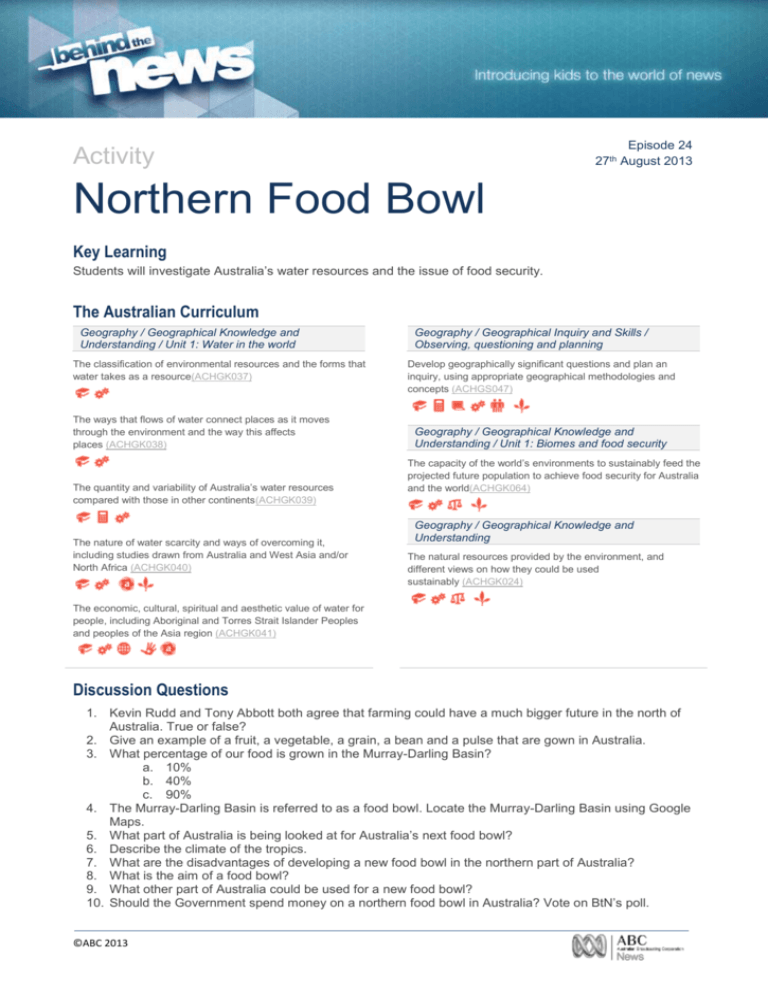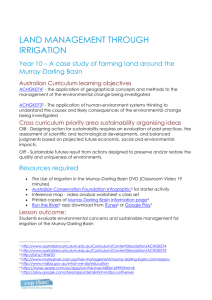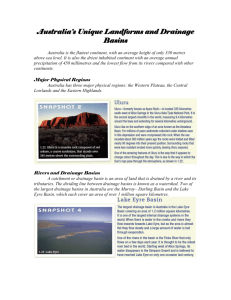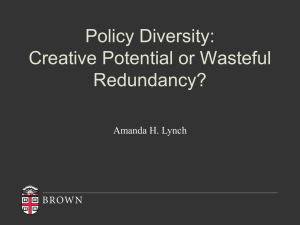WORD - ABC
advertisement

Episode 24 27th August 2013 Activity Northern Food Bowl Key Learning Students will investigate Australia’s water resources and the issue of food security. The Australian Curriculum Geography / Geographical Knowledge and Understanding / Unit 1: Water in the world The classification of environmental resources and the forms that water takes as a resource(ACHGK037) The ways that flows of water connect places as it moves through the environment and the way this affects places (ACHGK038) The quantity and variability of Australia’s water resources compared with those in other continents(ACHGK039) The nature of water scarcity and ways of overcoming it, including studies drawn from Australia and West Asia and/or North Africa (ACHGK040) Geography / Geographical Inquiry and Skills / Observing, questioning and planning Develop geographically significant questions and plan an inquiry, using appropriate geographical methodologies and concepts (ACHGS047) Geography / Geographical Knowledge and Understanding / Unit 1: Biomes and food security The capacity of the world’s environments to sustainably feed the projected future population to achieve food security for Australia and the world(ACHGK064) Geography / Geographical Knowledge and Understanding The natural resources provided by the environment, and different views on how they could be used sustainably (ACHGK024) The economic, cultural, spiritual and aesthetic value of water for people, including Aboriginal and Torres Strait Islander Peoples and peoples of the Asia region (ACHGK041) Discussion Questions 1. Kevin Rudd and Tony Abbott both agree that farming could have a much bigger future in the north of Australia. True or false? 2. Give an example of a fruit, a vegetable, a grain, a bean and a pulse that are gown in Australia. 3. What percentage of our food is grown in the Murray-Darling Basin? a. 10% b. 40% c. 90% 4. The Murray-Darling Basin is referred to as a food bowl. Locate the Murray-Darling Basin using Google Maps. 5. What part of Australia is being looked at for Australia’s next food bowl? 6. Describe the climate of the tropics. 7. What are the disadvantages of developing a new food bowl in the northern part of Australia? 8. What is the aim of a food bowl? 9. What other part of Australia could be used for a new food bowl? 10. Should the Government spend money on a northern food bowl in Australia? Vote on BtN’s poll. ©ABC 2013 Activities Examine Australia’s bays, rivers, waterfalls and lakes As a class brainstorm as many bays, rivers, waterfalls and lakes in Australia as possible. Record your student’s answers on the interactive whiteboard or on a large piece of white paper. It is also one of the largest river systems in the world and one of the driest. It is divided into the northern Basin (Darling system) and the southern Basin (Murray system). Provide students with the opportunity to find out more about the Murray-Darling Basin! Encourage students to gather information from a variety of sources. There are some website links at the end of this activity sheet that may be useful. Students will identify the Murray-Darling Basin using Google Maps. Students will create their own map of the Murray-Darling Basin and include the following: Inset Compass Key Symbols Scale Research Questions Where is the Murray–Darling Basin? How big is the Basin? What are the key features of its landscape? Why is water so important? What are the major towns and cities within the Murray-Darling Basin? Why is it important to Australia and Australians? What is my responsibility for its protection and preservation for the future? Many people depend on the Murray-Darling Basin for their livelihoods. What is meant by this statement? Why is it referred to as a ‘basin’? Helpful information for students: Murray-Darling Basin Authority: for Students – http://www.mdba.gov.au/what-we-do/education/students Murray-Darling Basin Authority: About the Basin – http://www.mdba.gov.au/about-basin Challenge your brain with this memory game and learn about the amazing plants, animals, landscapes and communities of the Murray–Darling Basin as you go! ©ABC 2013 Catchment detox is an online game that puts you in charge of the whole catchment. You decide what activities you undertake — whether to plant crops, log forests, build factories or set up national parks. The aim is to avoid environmental problems and to provide food and wealth for the population. Clean up the river is an interactive flash game for primary school students. It aims to stimulate kids to learn about the impact of rubbish on their local river systems. Water storages are at a critically low level. You have been assigned to the Wilson Family household to save water. Move through their house, exploring each room to discover water-saving tips and hidden videos. Play all eight fun and interactive games. Define these terms Students will think about what the words ‘water’, ‘scarcity’, ‘food’ and ‘security’ mean in the context of the BtN Northern Food Bowl story. Students will compare their definitions. Come up with a class definition for Water Scarcity and Food Security. Discussion Questions Do you think the population of Australia has enough food to eat? Can you name any other countries around the world that have enough to eat? Can you think of any countries where you think that not all the population has enough food to eat? Think about the geography of these places, for example, climate, culture, technology, soil quality. Discuss the advantages and disadvantages of the Northern Food Bowl plan. Can you think of any strategies to help with water scarcity or food security? Discussion Questions What is the aim of a food bowl? Why is it such a complex problem? Think about the environmental, social, political, economic and cultural reasons. What are the advantages and disadvantages of expanding irrigation in the north of Australia? ©ABC 2013 Classroom debate Before preparing for your classroom debate invite students to participate in a class discussion on whether they think the northern food bowl plan is a good idea. Consider creating a SWOT chart using the table below. Preparing for your class debate A debate is traditionally held between two teams of three speakers. The speakers are given the same topic. One team is called the ‘Affirmative’ and speaks in support of the topic. The other team is called the ‘Negative’ and speaks against the topic. Other roles that can be assigned are chairperson, time keeper and the remaining class members can give feedback to the speakers. Discuss with students the length of time each speaker talks for. Students will need sufficient time to research the topic. Strengths Weaknesses Opportunities Threats Once roles are assigned ask each team to prepare for the debate as per the following: List your arguments and write in point form. Highlight your five best points. These points will be used for the debate. On cue cards, write in point form a beginning (introduction), middle (five best points) and ending for your speech. Practise your speech using your cue cards. Guide for giving feedback Was the information clear and accurate? Were the arguments logical? Were the counter arguments accurate and relevant? Comments about the presentation style (tone of voice, body language, enthusiastic, convincing). Reflection How difficult was it to think of points to support one side of the argument? Do you think you would have done a better job supporting the other side of the argument? Related Research Links ABC Lateline – Northern food bowl ‘a myth’ http://www.abc.net.au/lateline/content/2013/s3826849.htm Liberal Australian Party – Food Bowl within reach https://www.liberal.org.au/latest-news/2013/06/21/food-bowl-within-reach Global Education – Food Security http://www.globaleducation.edu.au/global-issues/gi-food-security.html ©ABC 2013 RiAus – Food Security http://technyou.edu.au/wp-content/uploads/2013/03/RIAus_PDPlus-Food-Security-Accessible.pdf Behind the News – Food Bowl http://www.abc.net.au/btn/story/s2823678.htm Behind the News – Basin Plan http://www.abc.net.au/btn/story/s3038364.htm Behind the News – Murray Darling http://www.abc.net.au/btn/story/s2214520.htm ©ABC 2013






